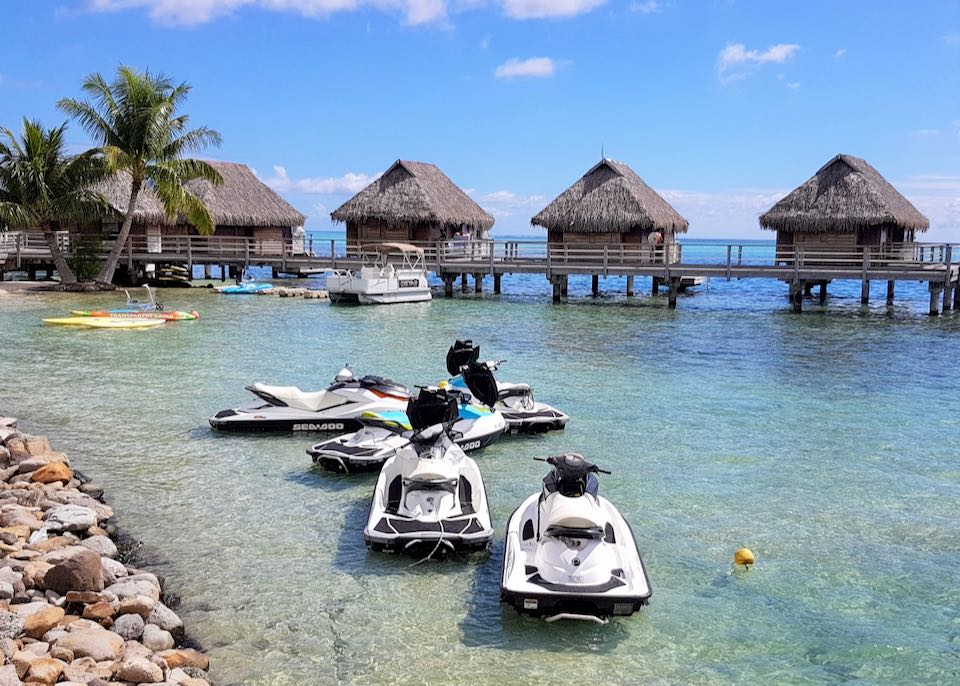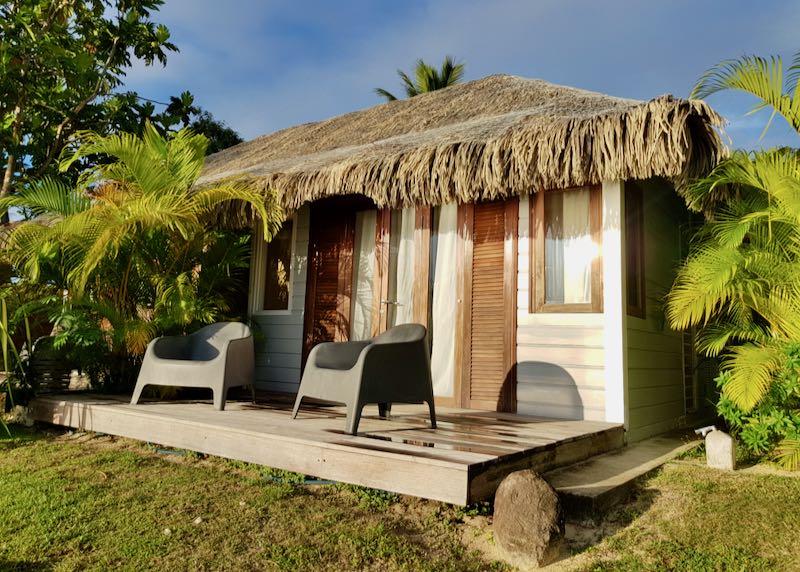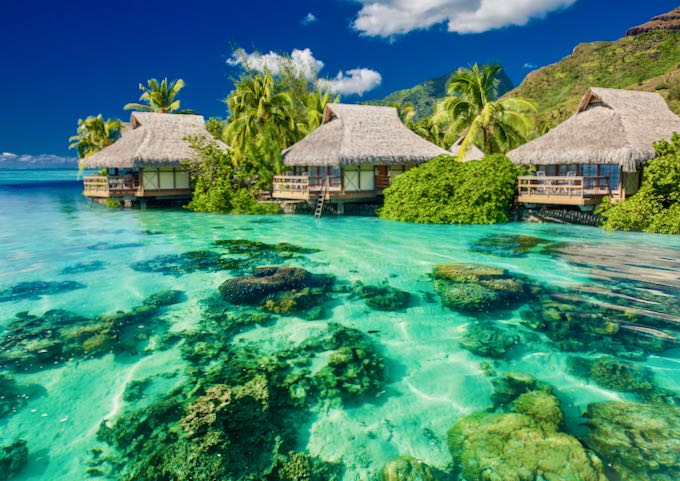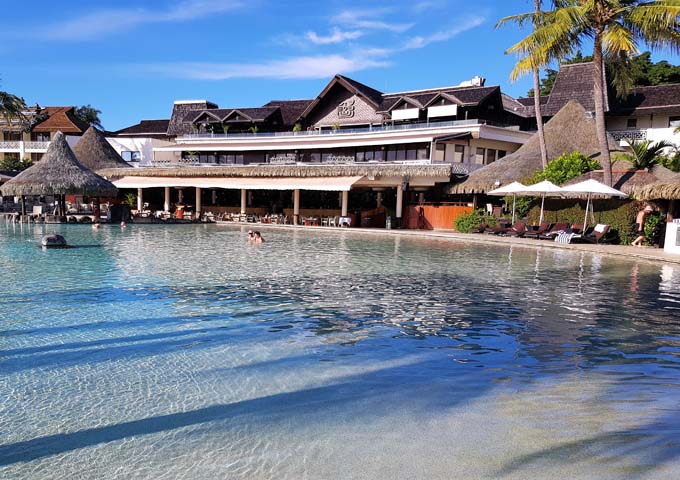
The marvelous Manava Beach Resort & Spa Moorea in Tahiti.
The Best Areas to Stay in Tahiti
About halfway between Australia and America, Tahiti is firmly part of French Polynesia, yet over 15,500km from Paris. The 5 archipelagos of 120 islands and atolls rightly invoke images of tropical paradise with white sands, sloping palms, and turquoise lagoons, and islands with exotic names like Bora Bora populated by gorgeous young ladies in grass skirts and portly old men playing ukuleles. But there’s even more: rainforests peppered with waterfalls, mountainous interiors begging to be explored, ruins of villages that predate colonization, and world-class diving among shipwrecks and luminescent reefs.
Still substantially French in history, culture, food, and of course, language, Tahiti is not as developed as its Melanesian cousin: New Caledonia (which is rich in nickel). Tahiti is more urbanized than Fiji and Vanuatu, but also among the most expensive places in the Pacific, with costs exacerbated by the isolation. Tahiti does receive vast amounts of aid from France, yet many residents – predominantly the unemployed and indigenous – still actively seek independence.
About 75% of the territory’s population lives on Tahiti island, which is almost divided into 2. The overwhelmingly larger section, Tahiti Nui (Big Tahiti), is home to the capital, Pape’ete, with the airport, marinas and majority of facilities, and its suburbs which stretch down the west coast. Attached by a narrow isthmus to the southeast is Tahiti Iti (Small Tahiti). Often forgotten and poorly developed, the villages and lifestyle are more authentically Polynesian, and the surf is among the scariest on earth.
Tahitians and tourists who tsk-tsk the over-development, crowds, and traffic of Pape’ete and western Tahiti Nui flock to Moorea Island, barely 30 minutes by ferry from the city center. Almost condensed enough to cycle around, this enchanting island offers comparatively undeveloped snow-white beaches and enclaves radiating a tropical holiday vibe.
Other islands providing dreamy beaches, authentic island life, and abundant outdoor activities include Maupiti, Ra’iatea, and Huahine, each easily accessible from Tahiti, and with enough facilities to satisfy most tourists. And then there’s la crème de la crème: Bora Bora. Perhaps a little over-hyped and certainly overpriced, this exotic Tahitian pearl is, nonetheless, divine.
All islands mentioned above are part of the Society Islands, certainly the largest of the 5 archipelagos. The other remote island groups are: the Australs, consisting of 5 inhabited atolls to the south; the Tuamotus, with numerous far-flung atolls of heavenly beaches; the Marquesas, a dozen mountainous islets, unusually with no lagoons; and the Gambiers, about 1,700km from Pape’ete.
The Best Places to Stay in Tahiti
The beachfront bungalows at Moorea Beach Lodge are charming, low-key, and good value.
- Best Luxury Hotels in Tahiti
Manava Beach Resort & Spa Moorea • InterContinental Tahiti Resort & Spa • Sofitel Kia Ora Moorea Beach Resort- Best Boutique Hotels in Tahiti
Moorea Beach Lodge • Fenua Mata’i’oa Hôtel- Best Cheap/Midrange Hotels in Tahiti
Pension de la Plage • Tahiti Surf Beach Paradise • Fare D’hôtes TutehauBest Areas in Tahiti for …
The best area for first time visitors to Tahiti: Moorea Island.
- Best Region in Tahiti for Beaches: Tuamotu Islands
With some of the most attractive beaches on the planet, it seems unfair to choose just 1 region of Tahiti, but perhaps the finest are those in the far-flung Tuamotu Archipelago, strung out some 350km from Tahiti Island. The 77 atolls are exquisite jewels among waters shimmering with every shade of blue and green. Expect bleached-white sands with almost pink hues, and palms bent at unlikely angles. The most accessible beaches are at Tikehau, oozing a timeless beauty, and pleasingly under-developed; and Fakarava, renowned as one of the most exquisite in all of Polynesia, with the added bonus of legendary diving and snorkeling.- Best Region in Tahiti for Diving & Snorkeling: Moorea Island
Moorea is almost completely surrounded by a reef (with only 12 navigable passes), so the waters are calm, shallow, and rarely affected by tides. As well as abundant marine life, including turtles, harmless sharks, eels, and barracudas, divers relish the vibrant coral, subterranean caves, and curious dolphins. And many of the island’s underwater delights are accessible just offshore with a snorkel and mask. The diving is not challenging, so it is ideal for novices, and the visibility is almost always wonderful. There are several dive operators in the tourist regions, and Moorea is close enough from Pape’ete to daytrip by passenger/car ferry, and only 10 minutes by air.- Best Region in Tahiti for Outdoor Activities: Moorea Island
The petite sister to Tahiti Island, Moorea is where knowledgeable locals and tourists flock for pristine beaches, fish-filled lagoons and every type of activity under the sun. The adrenaline-pumping includes abseiling, surfing, scuba-diving, sky-diving, kite-surfing, quad-biking, and all sorts of water sports often not available elsewhere in the Pacific, such as jet-skiing. More sedate activities include whale-watching (August to November), and hiking along well-established trails in the mountains. And families would relish the chance to paddle board, kayak, and snorkel among the lagoons, or cycle along the flat 60km coastal road.- Best Region in Tahiti for Surfing: Teahupoo (Tahiti Iti)
The southern edge of Tahiti Iti (which seems to hang off the bottom of Tahiti Nui) is home to magical – and frightening – waves that attract surfers who don’t care about the rough roads and limited facilities. Blessed with a unique combination of swells, seabeds and winds, Teahupoo hosts one of several major surfing competitions across the territory. But these waves are strictly for experts, although there are milder options nearby. And it’s worth visiting just to watch the brave – or foolhardy – from the safety of the shore.- Best Region in Tahiti for Boating: Ra’iatea Island
While much of the coastline in the Tahitian capital, Pape’ete, is lined with marinas, yachties in the know often end up at Ra’iatea. Centrally located among the largest archipelago (the Society Islands) about 200km from Pape’ete, there are few beaches and fewer tourists, so the island is more authentic. But as the second-largest town in the territory, Uturoa has decent facilities, including a market to stock up on fresh supplies, and bars for swapping tall stories. Most berth at the world-class Apooiti Marina, also home to several boat charter companies.- Best Region in Tahiti for Shopping: Pape’ete
Not surprisingly, the finest shops are in the capital, where most well-heeled residents live, and many affluent visitors stay for at least a short while, if only because it’s home to the airport. More inviting than the couple of suburban malls are the boutiques along or just off the esplanade offering designer label goods imported from Europe, and souvenirs such as the black pearls for which the Tahitian islands are so renowned. And the enormous daily market in downtown sells, among other things, tropical fruits and authentic souvenirs.- Best Region in Tahiti for Food & Restaurants: Pape’ete
The choice around the capital reflects the multicultural makeup of the islands, with Chinese, Indian, Japanese, and of course, French cafés, restaurants and bistros. Fresh, tasty, and often, spicy seafood is a specialty, and the best places to try traditional food, such as poisson cru (raw tuna in lime juice), are the roulottes (food carts) that pop up out of nowhere in the evening. The most scenic places to wine and dine are around the marinas along the esplanade, while the city is also affluent enough to host a few internationally known fast-food outlets. For those using kitchens often featured in rooms, the vast market sells an extraordinary range of fruit, vegetables, meat, bread, and fish.- Best Region in Tahiti for Nightlife: Pape’ete
Much of the capital seems to close down at about 5pm, and after dark, parts of the city, especially around the ferry terminal, can be downright unsettling. Stick to the well-lit streets along and just off the esplanade, or take a taxi later at night. There are no shortage of bars selling nothing much but beer and liquor, but some do provide live music, especially on weekends. Resorts not far from downtown, such as Le Méridien and the InterContinental, often feature Polynesian shows with fire and dance. Otherwise, catch a movie, look out for a traditional performance (especially around the June-July festival time), or slink into a nightclub of cool DJs with trendy names. The very handy What’s On magazine (in English and French) is available at most hotel lobbies.- Best Region in Tahiti for Markets: Pape’ete
Most villages around the islands are under-developed, so markets are still the primary source of shopping. Supermarkets have certainly replaced these in larger towns, but the capital still boasts the magnificent Marché de Pape’ete. Vast, undercover, and conveniently located in downtown, the variety is exceptional. Open early, sometimes from 4am, it’s also the perfect place to buy arts, crafts, clothes, and souvenirs from around the Tahitian islands, including hats and baskets of pandanus leaves from the Austral Islands; carvings in stone and wood from the Marquesas; pearls from Moorea; and pareau (like a sarong) from Hauhine. And why not buy a ukulele?- Best Region in Tahiti for Families: Moorea Island
Moorea offers a broad range of accommodation, several attractive beaches, and 2 tourist enclaves (Maharepa and Hauru) with shops to potter about, and cafés to relish. The coastal road is fairly flat, with minimal traffic, and hence, ideal for cycling and walking. Added attractions include horse-riding; water sports, like kayaking and kite-surfing; whale-watching (August to November) from the coast or on boats; and snorkeling just offshore among colorful fish and dense coral. And proximity by plane or car/passenger ferry to Tahiti Island avoids lengthy and pricey inter-island connections.- Best Region in Tahiti for Vibe & Culture: Gambier Islands
As expected, the further from the modern influences of Pape’ete, the more authentic the villages, customs and lifestyles. In the faraway Gambiers, some 1,700km from Tahiti Island, Polynesian traditions continue unaffected by the tourism onslaught elsewhere, and smiles seem permanently attached to everyone – foreign and local. Accommodation is limited to family-run lodges where guests usually eat with the locals. Tourists are a genuine rarity, and despite the number of whitewashed Catholic churches built from coral rock, these islands have had far less colonial (and current) interaction with France.- Best Region in Tahiti for Romantic Holidays: Bora Bora
It’s hard to imagine a dreamier destination among the tropical island paradise of Tahiti. The blue-green lagoons teem with multi-colored fish and vibrant reefs, and motu atolls are often home to just 1 magnificent 5-star resort offering intimacy, serenity, and privacy. Much of the accommodation is in above-water bungalows perched above lagoons at least 50m offshore, and accessible along piers radiating from the coast. Private sundecks offer 180-degree views of the Pacific, and a ladder down to the shallow waters. Many resorts on Bora Bora also provide romantic extras, such as candlelit dinners on the beach, and massage rooms for couples.The Best Regions in Tahiti for Tourists
The InterContinental Tahiti Resort & Spa in Pape’ete.
Pape’ete
The Tahitian capital has very little in the way of beaches and, therefore, resorts, but many visitors are attracted by the cosmopolitan lifestyle, and not just its convenience to the airport and ferry terminal for Moorea. Sections of the city are scruffy (particularly around the terminal), and a little unsettling after dark (e.g. the inner northern suburbs), but the coastline of marinas, parks and paths was being upgraded in 2018 with hopes that it may rival Noumea in New Caledonia. The frequent festivals, trio of museums, and massive market are all worth visiting, but the constant traffic jams are a bane for all.
- Best Hotel: InterContinental Tahiti Resort & Spa
Tahiti Nui
Pape’ete dominates the northwest tip of the main island, which is almost divided into 2: Tahiti Nui (Big Tahiti), and the diminutive Tahiti Iti (Little Tahiti). The 120km-long coastline of The Big One is best explored by rented car, because motorbikes are not available, and public buses, frustratingly unreliable. Along the single coastal road, there are historical remains at Arue, a surf beach at Papenoo, museum at Puna’auia, caves at Paroa, and botanical gardens at Vaipahi. But the occasional beach is usually grey, often black, and most of the few resorts are midway along the west coast.
- Best Hotel: Le Méridien Tahiti
Tahiti Iti
Forgotten by most is the tiny ‘island’ seemingly hanging off the southeast coast of Tahiti Nui. Considerably less developed, with bumpy roads finishing at settlements along both coasts, this area is a more authentic slice of Polynesian life. Locals are more focused on agriculture than tourism, with infrequent lodges only accessible by car. The more adventurous come for the deserted beaches, world-class surfing, magical hiking trails, and scuba-diving.
- Best Hotel: A Pueu Village
Moorea
Meaning ‘Yellow Lizard’ in the local language, Tahiti Nui’s sister island is home to about 20,000 people, some of whom commute to Pape’ete only 30 minutes away by car/passenger ferry. (The flight, less than 10 minutes, is one of the world’s shortest.) The interior is volcanic, with lush forests and permanent waterfalls, but most locals live on the 60km-long coastline, and the majority of tourists stay in or around the expat enclaves of Maharepa and Hauru. Apart from the usual beaches, lagoons and reefs, this W-shaped island offers vanilla and pineapple plantations, a plethora of adventure activities, and archaeological remains predating colonization.
- Best Hotels: Manava Beach Resort & Spa Moorea
Bora Bora Island
Regarded by many as the quintessential tropical island paradise, and particularly popular with honeymooners, Bora Bora is based around lagoons with differing shades of blue and green. The motu atolls encircling the main island are only accessible by boat, and most are commandeered by only 1 magnificent resort. The 10,000 inhabitants live on the central island, dominated by 2 mountains, and home to Bora Bora’s only town: Vaitape. There isn’t much to do but snorkel and snooze, but that’s part of the attraction. And note: prices are probably the highest in the Pacific; flights are expensive and often full; and there is a surprising lack of accommodation, so book ahead.
- Best Hotel: InterContinental Bora Bora Le Moana Resort
Huahine Island
Rivaling Bora Bora for beauty and serenity, Huahine also offers a fine range of facilities across 2 islands connected by a bridge. Expect the usual: lagoons of blue and green hues, hiking among mountainous terrain with waterfalls, amiable villages, and snorkeling among profuse marine life. But Huahine is not on the usual tourist trail, so it’s more authentic, and there are remarkable ruins to explore at Maeva. Expats rushing to set up bars and lodges revel in the laid back vibe, which also appeals to backpackers.
- Best Hotel: Hotel Royal Huahine
Maupiti Island
Shaped much like Bora Bora, but not nearly as over-hyped, Maupiti is another slice of paradise. Meaning ‘2 Mountains’ in the local language, it offers pretty much the same as its more fancied neighbors, but is not nearly as developed and crowded, which does mean that facilities are limited. The beaches are snow-white, particularly at Tereia, while the adventurous few relish hiking along mountainous trails, and diving (and snorkeling) among turtles, sharks and manta rays in the sapphire lagoons. Locals live inland, but most visitors stay in 1 of the family-run lodges on the coast. No resorts here (yet).
- Best Hotel: Maupiti Residence
Ra’iatea Island
More developed than most islands, and with Tahiti’s second-largest town (Uturoa), Ra’iatea offers the usual lagoons teeming with fish, secluded atolls, traditional villages, and mountainous interior, but it doesn’t boast the divine beaches of its neighbors. Tourists are therefore fewer, but the roads and tourist facilities are still quite impressive. Added attractions are the longest river in Polynesia (accessible by canoe), fishing trips on chartered boats, diving among rare shipwrecks, relics of pre-colonial settlements, and a range of excellent accommodation from family-run lodges to resorts rivaling Bora Bora.
- Best Hotel: Hôtel Raiatea Lodge
Taha’a Island
Only accessible by boat from neighboring Ra’iatea, Taha’a is usually ignored and therefore, always unhurried. Unlike its neighbors, the island is not so mountainous, and the vegetation is different. Surrounded by numerous uninhabitable motu atolls, almost all residents live, and most visitors stay, on the main island, but there’s plenty to do elsewhere: canoe trips around the lagoons, snorkeling among unblemished reefs, and visits to pearl farms or vanilla plantations. Most accommodation is in chic resorts.
- Best Hotel: Le Taha’a Island Resort & Spa



About Santorini Dave